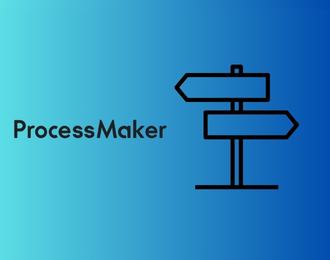 Similarly, a recent Gartner survey found that 45% of CIOs are driving a shift to co-ownership of digital leadership, recognizing that a ‘franchise model’ is more successful, where business leaders across the enterprise are active participants in change programs.
Similarly, a recent Gartner survey found that 45% of CIOs are driving a shift to co-ownership of digital leadership, recognizing that a ‘franchise model’ is more successful, where business leaders across the enterprise are active participants in change programs.
Gartner research notes that “CIOs have already been laying the foundation for democratized digital delivery with technologies such as low code platforms, which 64% of CIOs said they have deployed or plan to deploy in the next 24 months.”
Democratization makes sense, because the employees best equipped to identify areas where digitalization could deliver benefits are the ones who grapple with legacy, paper-based processes daily.
With no code tools they can pursue user-centric design, where so-called citizen development is more likely to address the pain points in a business process and come up with workflows that better align with user expectations. Giving employees a better experience is another benefit of no code process automation.
A recurring issue with IT solutions is that they are often too complicated and resisted by the employees who are supposed to use them. A Gartner survey found that 60% of employees experience frustration with new software.
Citizen development overcomes this pitfall with a much greater probability of user adoption because the process is built by the people who are close to it, which results in a faster return on the investment in the tool that made it possible.
Process users and administrators will break down bottlenecks and make themselves more productive. For project leaders in construction, for example, where temporary sites are over reliant on paperwork, quick wins can be made with workflows around health and safety and field reporting.
Read a FlowForma construction case study: Downer New Zealand
In healthcare, administrators who want to affect change without wrestling with vast IT systems, can transform something like the filing of post-surgery theatre notes with a simple workflow automation tool.
Read a FlowForma healthcare case study: Blackpool Teaching Hospitals NHS Foundation Trust
In utilities or manufacturing, department heads can cut out paperwork in the supply chain or quickly build processes to keep up with new regulations.
Read a FlowForma utility case study: Nipro Europe Group Companies
One risk with workflow automation is the danger of ‘shadow IT’, where different departments use different tools without proper governance. While the benefits of self-service workflow design are clear, it’s most effective if it’s overseen by heads of IT or operations and approved by Chief Financial Officers. Buy-in from the board will deliver the enterprise-wide benefits that workflow automation is capable of.
4. Outcomes of workflow automation
True business transformation is achieved incrementally, not with ‘big bang’ IT projects that have a high failure rate. This is why workflow automation is such a powerful agent of change, a low-risk way to digitalize multiple parts of an enterprise.
We have seen how empowered users in different roles can transform their area of business, given the tools to do it. And when no code workflows cross over into adjacent departments, other line of business managers will like what they see and start to build their own processes.
In this way, digital transformation gathers momentum, something that is expected to accelerate further with the rise of AI.
According to Gartner’s recent CIO survey, 70% of respondents believe AI is a game-changing technology that will rapidly advance the democratization of digital delivery beyond the IT function. While only 9% of CIOs have already deployed generative AI technologies, over half (55%) say they will deploy AI over the next 24 months.
The same survey identified cybersecurity, data analytics and cloud platforms as the other top areas for CIO investment in the years ahead.
Digital process automation solutions align with cloud-first and data-centric strategies as well as the shift from capital to operational expenditure. FlowForma Process Automation, for example, is a secure, cloud-hosted tool with built-in data analytics, paid for on subscription.
Another reason why boards need to take workflow automation seriously – compliance officers and CFOs in particular – is that digital workflows are transparent and auditable. A single digital document repository is created, replacing paperwork that can get misplaced and lost. It encourages good governance and makes it easier to stay compliant with increasing regulatory demands. Paperless processes will also support sustainability in ESG programs.
Culturally too, workflows are a game-changer. Not only do they empower employees and encourage them to play a part in workplace transformation, successfully implemented workflows deliver a better user experience that drives collaboration and teamwork. A more connected employee experience (EX) is good for morale, which in turn is good for productivity.
No code tools with a single document repository provide another service that drives productivity. According to Gartner research, 47% of digital workers struggle to find the information needed to effectively perform their jobs. With properly executed digital workflows, all the documents around a process are stored in one place that’s easily searched. More time saved and good for governance, it benefits the employee and the business.
Employee job satisfaction is significant in other ways. In an analysis of HR trends towards 2025, KPMG identified the transition to digital workplaces as important for retaining staff. The report talks of integrating digital to create a frictionless and highly engaging working environment, and how “legacy solutions and processes will not be tolerated by employees in a competitive labor market”.
.png?width=400&height=400&name=of%20CIOs%20are%20driving%20a%20shift%20to%20co-ownership%20of%20digital%20leadership%20(1).png) Finally, C-suite executives should welcome citizen development because it’s a low-risk way of encouraging grassroots innovation in their organization.
Finally, C-suite executives should welcome citizen development because it’s a low-risk way of encouraging grassroots innovation in their organization.
Users creating their own workflows may be more willing to experiment with how they go about their jobs. They are more likely to try something new that they came up with themselves, as opposed to having something foisted on them by an outside business analyst who doesn’t understand the nuances of what they do.
Read FlowForma client stories in our customer success stories eBook demonstrating successful digital transformation.
5. Extend the scope of routine processes
There is no limit to the scope of workflow automation projects. Because the fundamentals of document processes are often quite simple and repeatable, newly created workflows can be shared, re-used and adapted by other parts of the business, saving more time and money, extending the value of the no code tool across the enterprise.
Workflows can contain a broad mix of content, from forms and templates to videos tagged with GPS data or files linked to third-party systems and processes. In construction, workflows can be integrated with survey and mapping applications to provide permits with a geographic visualization.
Interoperability with healthcare systems allows frontline clinicians to pull up data at the point of patient interaction, with prepopulated fields of patient details. Professional services firms can seamlessly connect processes with their time and billing applications to develop a workflow around payment.
For the best results, workflow tools should be cloud-native, which makes them easier to integrate with other systems, databases, and applications.
The cloud also liberates multi-site organizations from having to run and distribute software at different locations, and IT teams from having to keep it secure and up to date. The no code provider does this automatically. Remote access for a hybrid workforce is also better enabled from the cloud, with workflow tools available from anywhere, on any device – smartphone, tablet, desktop.
Cloud solutions also offer scale and flexibility, with open APIs that connect business systems and databases to business-critical applications like CRM and ERP.
An open tool like FlowForma Process Automation will slip seamlessly into the IT stack, connecting people and processes inside and outside of the organization. A mobile app will ensure stakeholders can interact with the workflow at anytime from anywhere. Using the Microsoft 365 environment, FlowForma Process Automation has even extended access to the public for anonymized form-filling.
Watch: FlowForma's Integration Manager Tutorial
Fundamental to any workflow is ensuring consistency of data between systems. Pre-populating forms will minimize pass-backs and reduce administration headaches. An extensibility framework will allow users to create product extensions and further customize their process. Security around the workflow software will protect and maintain data integrity.
6. Ensure continual business improvement
In Japanese business, kaizen is an approach to creating continuous improvement based on the idea that small, ongoing changes can reap significant gains. The practice recognizes that frontline workers often come up with the best ideas and can innovate and drive improvement.
The adoption of digital kaizen in professional services has been discussed in the Harvard Business Review, where no code and low code toolkits were identified as instrumental in empowering employees to innovate and improve business functions.
Having instigated grassroots improvement, the next step is to measure it. The role of analytics in driving organizational improvement is increasingly important, enabled by advanced business intelligence tools and AI-powered modelling. Smart workflow tools like FlowForma Process Automation incorporate analytics to measure the effectiveness of digital processes and their impact on the business.
Enterprise-wide workflows can be tracked at a granular level with dashboards for digging down into resulting revenue streams, support costs and profitability. Insights from the data will help identify hold-ups in procure-to-pay processes, for example, or recurring reasons why request forms are delayed, such as problem stakeholders.
The rise of AI workflow automation will accelerate a journey of continual improvement, using algorithms to analyze data and execute tasks more quickly than people. Machine learning models will assist in iterating process steps; generative AI can be used to summarize the output of completed forms. Concise process summaries will lead to faster and more informed decision-making and provide insights into how further automation could accelerate workflow effectiveness.
Read more about FlowForma’s analytics module
7. Why FlowForma Process Automation
.png?width=500&height=281&name=Three%20screenshots%20on%20different%20devices%20-%20BSA%20(placeholder).png) FlowForma has been setting the pace for no code automation for nearly a decade. Leading from the front, we have a track record of proven digital processes that have transformed organizations across wide-ranging sectors, from construction, finance and energy to healthcare, education and professional services.
FlowForma has been setting the pace for no code automation for nearly a decade. Leading from the front, we have a track record of proven digital processes that have transformed organizations across wide-ranging sectors, from construction, finance and energy to healthcare, education and professional services.
Ranked highly by user communities and analysts, FlowForma Process Automation is the fastest digital process automation tool on the market. Like the all market-leading software companies, we constantly iterate to improve functionality and performance. We recently introduced an analytics module, and right now we’re exploring how generative AI can be integrated into our software to make workflow creation even easier and faster.
Key features:
- All-in-one functionality – forms, document generation, workflow and analytics –in a simple-to-use tool
- Advanced reporting with a user-friendly analytics module for effortless dashboard creation
- Tight integration with Microsoft SharePoint and Teams for accelerating collaboration
- Pre-populated templates to transform generic processes such as product development, procurement, HR onboarding, health and safety.
- A single document repository makes it easy to store and file documents related to workflows
- A FlowForma mobile app enables users to access workflows via a mobile device
A simple-to-use tool that integrates with a wide range of IT platforms, systems and applications, FlowForma Process Automation addresses wide scale business transformation, one process at a time.
It is deployed as an instrument for gradual change, very different from large scale IT implementations where targeted outcomes are notoriously difficult to achieve. Uniquely, FlowForma Process Automation works for individual users and business leaders alike, and is a rare example of tool for change that brings everybody along on the digital transformation journey.
Are you to automate your workflows? Get started with a free 14-day free trial of FlowForma Process Automation (fill in the form below to get started!)
.png) By
By 
 Paul Stone, Product Strategist at FlowForma, describes digital workflows as
Paul Stone, Product Strategist at FlowForma, describes digital workflows as -1.png?width=500&height=274&name=Check%20out%20the%20success%20stories%20(2)-1.png) Having identified opportunities for process change, the next challenge is choosing the right tools for
Having identified opportunities for process change, the next challenge is choosing the right tools for 

.png?width=600&height=329&name=Check%20out%20the%20success%20stories%20(3).png)






